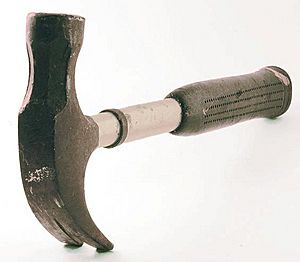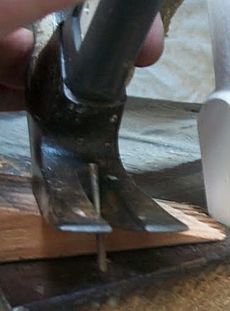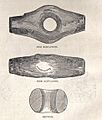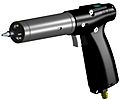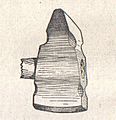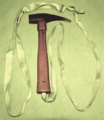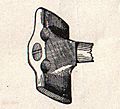Hammer facts for kids
- The hammers inside pianos are at Hammer (piano)
A hammer is a tool for putting nails into objects such as wood. It has a long handle, and a tip with a flat end for hitting nails. The most common type of hammer (sometimes called a claw hammer) has a curved end (on the other side of the hitting end) for pulling nails out.
A sledgehammer is a hammer that has a longer shaft, and a more massive head. The user can swing it with two hands and apply more force.
Contents
Designs and variations
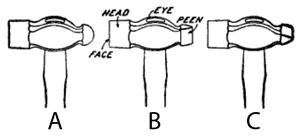
A large hammer-like tool is a maul (sometimes called a "beetle"), a wood- or rubber-headed hammer is a mallet, and a hammer-like tool with a cutting blade is usually called a hatchet. The essential part of a hammer is the head, a compact solid mass that is able to deliver a blow to the intended target without itself deforming. The impacting surface of the tool is usually flat or slightly rounded; the opposite end of the impacting mass may have a ball shape, as in the ball-peen hammer. Some upholstery hammers have a magnetized face, to pick up tacks. In the hatchet, the flat hammer head may be secondary to the cutting edge of the tool.
The impact between steel hammer heads and the objects being hit can create sparks, which may ignite flammable or explosive gases. These are a hazard in some industries such as underground coal mining (due to the presence of methane gas), or in other hazardous environments such as petroleum refineries and chemical plants. In these environments, a variety of non-sparking metal tools are used, primarily made of aluminium or beryllium copper. In recent years, the handles have been made of durable plastic or rubber, though wood is still widely used because of its shock-absorbing qualities and repairability.
Hand-powered hammers
- Ball-peen hammer, or mechanic's hammer
- Boiler scaling hammer
- Brass hammer, also known as non-sparking hammer or spark-proof hammer and used mainly in flammable areas like oil fields
- Carpenter's hammer (used for nailing), such as the framing hammer and the claw hammer, and pinhammers (ball-peen and cross-peen types)
- Cow hammer – sometimes used for livestock slaughter, a practice now deprecated due to animal welfare objections
- Cross-peen hammer, having one round face and one wedge-peen face.
- Dead blow hammer delivers impact with very little recoil, often due to a hollow head filled with sand, lead shot or pellets
- Drilling hammer – a short handled sledgehammer originally used for drilling in rock with a chisel. The name usually refers to a hammer with a 2-to-4-pound (0.91 to 1.81 kg) head and a 10-inch (250 mm) handle, also called a "single-jack" hammer because it was used by one person drilling, holding the chisel in one hand and the hammer in the other. In modern usage, the term is mostly interchangeable with "engineer's hammer", although it can indicate a version with a slightly shorter handle.
- Engineer's hammer, a short-handled hammer, was originally an essential components of a railroad engineer's toolkit for working on steam locomotives. Typical weight is 2–4 lbs (0.9–1.8 kg) with a 12–14 inch (30–35 cm) handle. Originally these were often cross-peen hammers, with one round face and one wedge-peen face, but in modern usage the term primarily refers to hammers with two round faces.
- Gavel, used by judges and presiding authorities to draw attention
- Geologist's hammer or rock pick
- Joiner's hammer, or Warrington hammer
- Knife-edged hammer, its properties developed to aid a hammerer in the act of slicing whilst bludgeoning
- Lathe hammer (also known as a lath hammer, lathing hammer, or lathing hatchet), a tool used for cutting and nailing wood lath, which has a small hatchet blade on one side (with a small, lateral nick for pulling nails) and a hammer head on the other
- Lump hammer, or club hammer
- Mallets, including versions made with hard rubber or rolled sheets of rawhide
- Railway track keying hammer
- Rock climbing hammer
- Rounding hammer Blacksmith or farrier hammer. Round face generally for moving or drawing metal and flat for "planishing" or smoothing out the surface marks.
- Sledgehammer
- Soft-faced hammer
- Splitting maul
- Stonemason's hammer
- Tinner's hammer
- Upholstery hammer
- Welder's chipping hammer
Mechanically-powered hammers
Mechanically-powered hammers often look quite different from the hand tools, but nevertheless, most of them work on the same principle. They include:
- Hammer drill, that combines a jackhammer-like mechanism with a drill
- High Frequency Impact Treatment hammer — for aftertreatment of weld transitions
- Jackhammer
- Steam hammer
- Trip hammer
In professional framing carpentry, the manual hammer has almost been completely replaced by the nail gun. In professional upholstery, its chief competitor is the staple gun.
Tools used in conjunction with hammers
- Anvil
- Chisel
- Pipe drift (Blacksmithing - spreading a punched hole to proper size and/or shape)
- Star drill
- Punch
- Woodsplitting maul – can be hit with a sledgehammer for splitting wood.
- Woodsplitting wedge – hit with a sledgehammer for splitting wood.
Images for kids
-
A modern claw hammer suited to drive and remove nails
-
Cartwheel mallets with heads of felt held between steel washers for use with timpani drums
-
A geologist's hammer used to break up rocks, as seen in archaeology and prospecting
-
A stone hammer found in Dover Township, Minnesota dated to 8000–3000 BCE, the North American Archaic period
-
16th-century claw hammer; detail from Dürer's Melencolia I (c. 1514)
See also
 In Spanish: Martillo para niños
In Spanish: Martillo para niños


